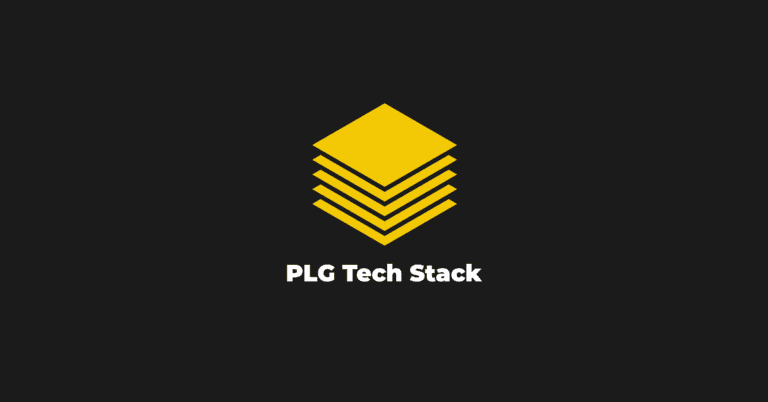All product-led companies share the same problem: how teams can move fast while still staying aligned.
No matter if you’re starting from scratch or if you are building on existing products, alignment is the all important grease that keeps the wheels of the product team moving forward.
Clear, decisive leadership creates a performance culture. That's why you set goals. By setting goals, you nurture trust. It encourages a spirit of collective improvement by challenging each other.
This article will touch on the key ingredients of product planning that fosters alignment between teams, and it’s what Hotjar uses to stay aligned.
- How to go about annual and quarterly goal setting
- How tribes and squads set goals
- The importance of creating a Quarterly Goal Hub
Then we’ll look at the role of product managers within goal setting, and the 3-phase system we use to create and foster a dynamic and collaborative product team.
But first, how to think about goal setting
Goal setting is not about building a priority list or prescribing a sequence of steps. Rather, it's the identification of where the goalposts are and providing teams with the flexibility to reach them.
Decoupling work from goal-setting is essential because it sets the tone for what you expect from product managers as part of their day-to-day responsibilities. This can also help make goal setting lightweight so that it doesn't feel like a massive undertaking each month, quarter, or half-year.
1. How to go about annual and quarterly goal setting
Hotjar’s objectives are set along key metrics on an annual basis. The intentions of our annual objectives stay steady throughout the year, even when our weekly or quarterly objectives change in response to the marketplace.
Here are a few things to think about as you move through goal setting:
- The cadence of your goal-setting cycles: this should support your overall strategy. Whether it’s every two weeks, every month, or every quarter. Plan in a way that is aligned with a calendar. For example, at Hotjar, we've recently embarked on a new three-year product strategy. So that said, with a three-year product strategy, we have annual company objectives and then tribe and squad quarterly objectives.
- Be flexible in how you achieve your goals: for example, if you set a quarterly objective to convert a hundred new customers, then there's a ton of wiggle room and flexibility to determine how to do that. If one approach doesn't work, then you can try another one without having to set an entirely new objective.
- Get everyone on the same page: at Hotjar, the operations team publishes a goal-setting calendar each quarter so the entire company knows what's expected to happen, when, and by whom. This helps foster alignment on timeline and expectations in a simple and clear way.
- Set everyone’s expectations long in advance: this will ensure things won’t crumble when team members are out sick or take a vacation.
From there, goals are further refined by tribes and squads.
2. How tribes and squads set goals
Many companies are broken down into “tribes,” or teams, such as design, data, and engineering. Each tribe then has a number of “squads” that focus on different points of the customer journey.
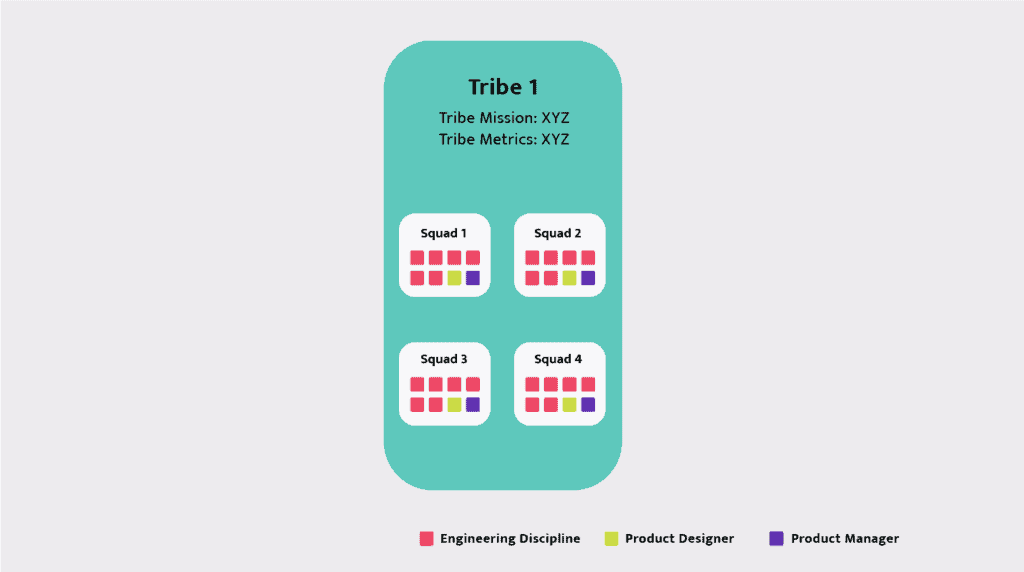
Here’s how each of these look at goal setting :
- Each tribe has its own goals and objectives that support the company-wide annual objectives. Setting goals at a higher level creates alignment for all of the squads within each tribe.
- Objectives for the tribe helps to steer all the squads in the same direction. This still provides them with plenty of flexibility to how they can reach the goals set at a company level.
An individual squad moving forward on its own can end up pursuing sub-optimizations and losing sight of how the sum of the product is greater than its parts.
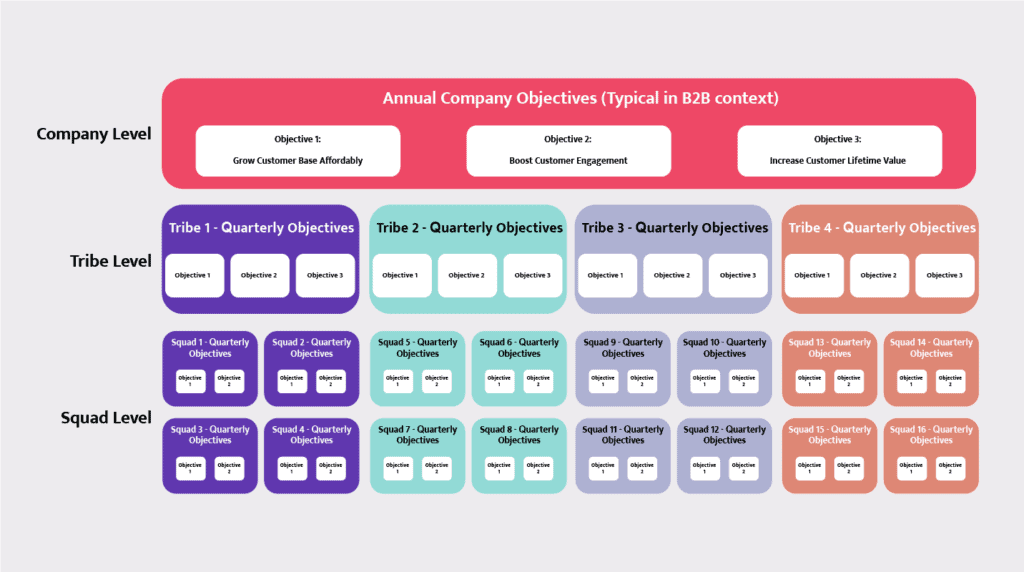
3. The importance of creating a quarterly Goal Hub
A quarterly Goal Hub is a simple artifact with a timeline. It’s linked to various boards, pages, metrics, dashboards, and so on. It provides specifics about which activities are assigned to each squad, product manager, tribe, or executive team member. It holds them all to the same level of accountability.
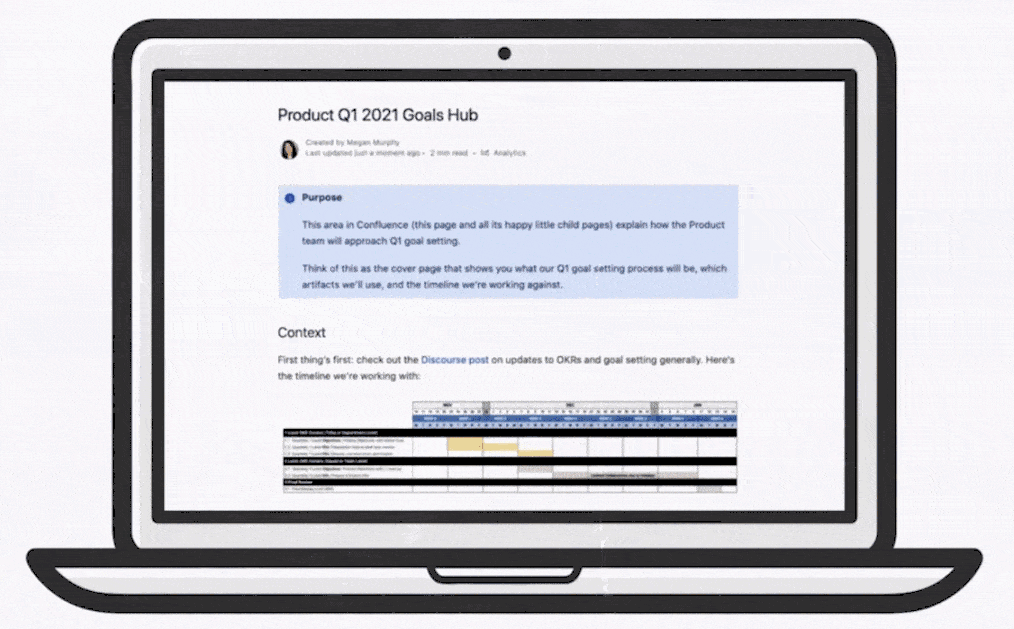
This allows you to:
- Ask questions. Capturing questions and responses within a system that is visible to everyone helps avoid the development of silos.
- Confront the human nature of your work. This type of system allows you to plan for holidays, scheduled leave times, company-wide events and other factors that may affect reaching your goals. Even if you have an ambitious quarter coming up, you can keep the realities of the human factor front and center. For example, if a team member is about to start maternity leave, you can plan to train someone
The role of SaaS Product Managers
If you want your product org to move fast and stay aligned, then creating the right rituals and artifacts as part of the day-to-day product manager role is key.
It is critical that goal setting is as lightweight as possible. Otherwise there is a risk that your team will experience planning fatigue.
It is the responsibility of product leadership to delineate between which activities constitute the normal ways of working as a product team and which are specifically tied to a goal-setting cadence.
Product managers can implement a number of activities that will contribute to goal setting while fostering a dynamic and collaborative product team.
For example, at Hotjar we have a 3-step process that contributes to goal-setting while still being part of the normal working process.
- Evidence Bank
- Opportunity Trees
- Impact Analysis
Evidence Bank
An evidence bank helps generate hypotheses for solutions that can then be analyzed outside of (but still contributing to) goal setting.
It’s an easy, searchable, and a go-to place of information, and it needs to be that way.
All SaaS product managers can contribute to the evidence bank. It is a single repository that is a mix of quantitative data, qualitative anecdotes, and market signals. The idea is that by having a single repository, the broader product team can spot evidence or trends they may not have found individually.
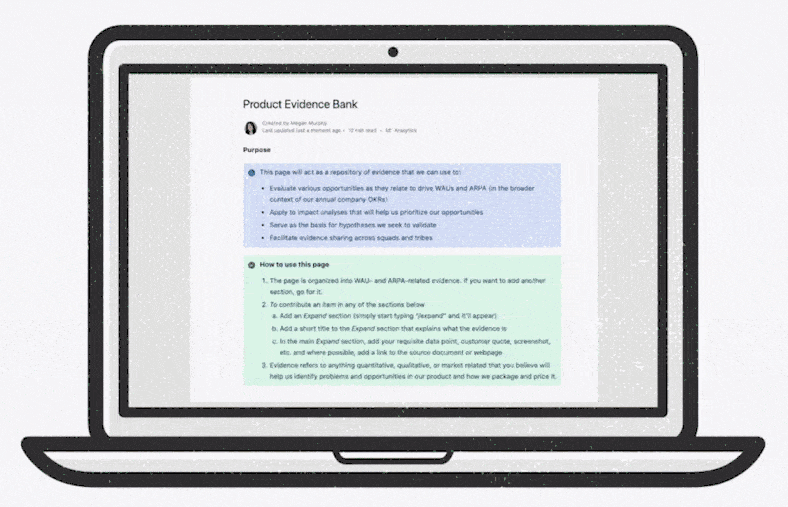
So how often do teams contribute to the evidence bank?
On average, Hotjar sees contributions to its evidence bank at least twice per week. In addition to screenshots, project managers include links to make sure everyone can easily access the source of every data point immediately and on time.
Of course, databases, dashboards, and more in-depth places exist to serve as warehouses for all these signals as well.
Pro tip: Finding the perfect solution for a given problem can take a long time and can be a frustrating process, often resulting in chaos, rework, and redundancy. But an imperfect solution is better than ignoring the problem entirely. Having a solution that relieves most of the pain is better than waiting indefinitely for a perfect solution. If you ever did find the “perfect” solution, you will probably have a new pain point to solve anyway.
Opportunity Trees
Opportunity trees leverage the data from the evidence bank. They help the product team stay organized and form hypotheses together.
Good ideas can come from anywhere or anyone on the team, no matter their role. Opening up an opportunity tree for anyone to contribute is important to generate ideation that both solves customer problems and helps your company achieve its objectives.
The process goes like this:
- Arrive at the board.
- View weekly active users, average revenue per accounts, and basic B2B metrics you're tracking. View a summary of the performance against each of those so that everyone has visibility.
- Move to the tree.
- Within the tree, there are tribe objectives and key results located to the left.
- Each product manager then outlines a variety of opportunities they believe will help everyone achieve the objectives.
- Product manager's then frame hypotheses, and link to the data in the evidence bank that informs their assumptions.
- These are then placed in the Solutions column. This is where product manager's capture their ideas, along with their squads’ ideas.
Note: As the VP of Product, I try to keep my involvement directly to the objectives and key results, and maybe sometimes the opportunities. In cases where I'm really itching to share an idea in the solution, I know that just because I put it here, doesn't mean it's going to get built or actioned. I also know that I need to hold myself to the same standard as everyone else: I back the proposed solution with evidence and assumptions.
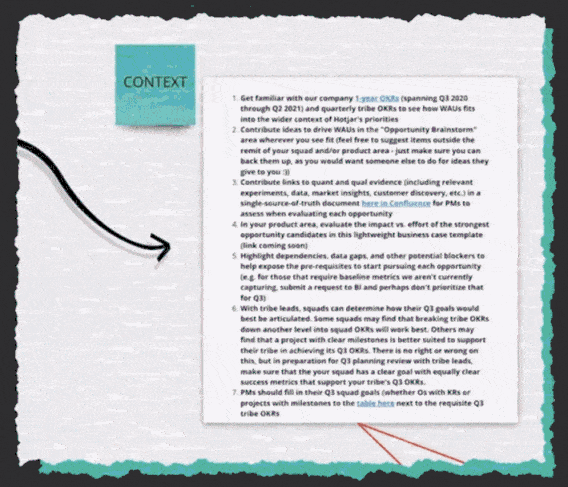
While good ideas can come from anywhere, not all of them are worth building—even if they’re great.
No matter the size of your company, sizing and selecting the opportunities worth pursuing is one of the most important responsibilities of a product manager.
Even if it takes a couple of attempts in iterations to find the right solutions, a focus on the right opportunity is absolutely critical to building a great product.
Impact Analysis
Every change comes with some degree of uncertainty.
The next step is an analysis to compare the predicted impact of maintaining the status quo verses pursuing one of the solutions from the opportunity trees.
The nature of the analysis varies depending on the nature of the opportunity. It might involve working with the finance team to help with modeling, or it might mean working with the engineering team to explore options and assess feasibility.
But a conclusion is stated that gives the audience closure and allows for reflection if the idea is ever developed.
Hotjar uses ultra-lightweight impact analysis templates to help product managers size the output from the opportunity trees. The analysis starts with a hypothesis, along with data that informed the assumption.
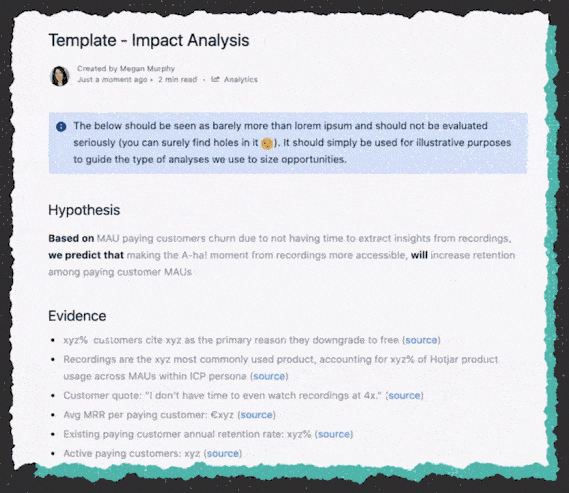
The ultimate goal is to give the product managers a lightweight, repeatable way to regularly evaluate opportunities. When it is time to set new goals, they can tap into opportunities that have already been assessed and set ambitious, but not unrealistic, goals.
Have Meaningful Discussions
The evidence bank, opportunity trees, and impact analyses are Hotjar’s core ways of working, not just things done during quarterly goal setting.
By making it clear that each of these three activities are core parts of the SaaS product manager role, it sets expectations on what leadership expects from product managers' performance and also makes each quarter more dynamic, less daunting, and more collaborative as a product team.
From there, have meaningful discussions to set those quarterly goals.
Begin the goal-setting discussion by contacting your product managers to discuss where the main focus is for the next time period. It’s important to evaluate your current performance against your annual objectives, along with the progress you have made against your product strategy.
This initial meeting can be an informal discussion where you come together to share the qualitative, quantitative, and market context that supports the objectives you think should be set.
Product managers can bring their questions, ideas, perspectives, and challenges. Harness the power of a collective of ideas and perspectives towards your improvements. From this point, refine the objectives for your tribes allowing for the product managers to plan their squad objectives.
How to make the most from Goal Setting
When we look at the bigger picture, it’s important to think outside these objectives to make the most out of the team and give them assurance as they move along.
Here are two ways to do this:
- Office Hours
- Challenge Days
Office Hours
As part of quarterly goal setting, consider having open office hours. This allows SaaS product managers to meet with leadership to discuss their ideas and concerns related to their objectives.
Set aside time each day, until the deadline of when goals for each squad should be finalized.
Make it optional, but invite everyone on the product team to book a slot to meet outside of a formal meeting.
Here are some tips for this:
- Drop any of the formality that accompanies a formal meeting. Office hours should be relaxed and informal. There is no need for product managers to waste time making pretty slides for a presentation.
- Facilitate a common time and space for people to speak, encourage organic conversations, and spontaneous interactions. This allows a natural, safe space to approach execs with hard questions that would seriously impact a product manager and their squad's work.
Challenge Days
Another activity that can greatly contribute to goal setting are Product Manager Challenge Days.
Pair up product managers in groups of two and have them challenge each other’s objectives, hypotheses, and impact analyses. Ideally, each product manager should partner with another manager who is not someone they work with every day.
The goal is to do a deep-dive on a specific topic.
These challenge days can foster a healthy feedback culture and give a natural way to cross-pollinate ideas across tribes and squads. They’re also great for peer mentorship and can help each product manager to avoid feeling like they're working on an island.
When everyone steps up to challenge each other in the pursuit of building one cohesive product experience, it cultivates a stronger team culture.
Putting it all together
Regular goal setting is not a prescription of to-do's or checklists.
It's a time to set ambitious, but not totally unrealistic goals, so that each team knows where they're going and how they're going to get there. Alignment is key because it makes sure that tribes and squads are moving forward in the same direction, not growing further apart.
Leadership needs to drive clarity and decision-making. They need to communicate timelines, activities, and ownership. This is critical.
Create a system that recognizes and embraces your team's constraints. If you set expectations upfront on what your capacity and availability are, you can all be aligned to pursue your objectives with ease.



